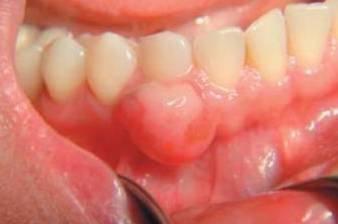Lumps / Masses / Growths
Schedule an appointment
Lumps, Masses, & Growths
Lumps can occur anywhere in the mouth: lips, gum tissue, cheeks, tongue, or palate. Such lumps or masses may develop quickly or gradually over months or even years. Some remain the same size and do not change their characteristics while others change in size, color, and symptoms such as pain. Most are benign masses and are not serious. Here are the most common forms of lumps, masses, and growths that occur in the mouth:
Fibroma
- A benign mass that forms in response to irritation
- They appear round and smooth with defined borders
- They are often painless unless they have been traumatized during chewing
- Treatment is complete excision or removal for biopsy

Mucocele
- A benign swelling that commonly occurs in the lower lip.
- A variation that forms in the floor of mouth under the tongue is called Ranula.
- It is due to ‘leaky’ ducts of damaged minor salivary glands of the lower lip.
- It often changes in size and recurs until treated.
- Treatment is complete excision of the lesion along with the damaged minor glands.

Inflammatory
- Some masses are inflammatory due to either bacterial or viral infection.
- One common form is known as granuloma.
- Treatment is complete excision and biopsy.

Papilloma
- A benign lesion that can occur anywhere in the mouth
- It is a soft lesion with a thin attachment to oral mucosa.
- It has appearance of ‘cauliflower’
- It is thought to be related to papilloma virus
- Treatment is complete excision and biopsy

Salivary Gland Stones
- Salivary gland stones may form in association with either sublingual or submandibular glands- It is referred to as Sialolithiasis
- It may cause partial or complete blockage of salivary flow
- Inflammation or infection of the involved salivary gland may occur (characterized by swelling, pain, or drainage)
- In most circumstances, the removal of the salivary gland stones is required (Sialolithotomy)

Torus / Exostosis
Torus and exostosis are bone growth anomalies commonly found on the palate (known as palatine tori), inside of the lower jaw bone (mandibular torus), and either inside or outside of the upper and lower jaw bones (exostosis). They are benign and in most individuals they do not cause any problems. However, they can enlarge gradually over time in response to bone apposition related to direct physical irritation during eating. In some circumstances, patients may develop traumatic ulceration and exposure of bone (known as dehiscence) leading to pain and discomfort.
Removal is mandibular tori, palatine tori, or exostosis is performed using an atraumatic and manimally-invasive techniques by utilizing special ultrasonic instruments.
